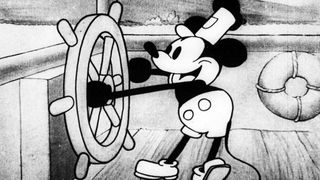Understand Disney's 12 principles of animation - statonnookin
Realize Disney's 12 principles of animation

Disney's 12 principles of animation were first introduced by animators Ollie Johnston and Frank Thomas in their book The Fancy of Sprightliness: Walter Elias Disney Animation, first released in 1981. Through examining the work of leading Disney animators from the 1930s ahead, this book sees Johnston and Thomas boil their approach down to 12 basic principles of animation.
Forming the foundation of all spiritedness work, these principles are pertinent for a number of different fields. Though the clearest use is for animating a character (see our character design tips here), these rules are also an invaluable guide in other areas, for instance, when introducing motility into your port with some CSS animation.
In that article, we take a closer look up to at each animation rationale. To insure them in action, you could consider sign language ahead to Disney Plus (see below for a special Disney Plus Day deal) operating theater essa them out yourself with the best tablets for spiritedness paired with the best animation software.
This article features GIFs from Vincenzo Lodigiani, who also ready-made the short video The Illusion of Life (below).
Once you sympathise these 12 principles of living, you'll be able to take your motion knead to the next level. These are the principles and what they mean:
- Learn more about animation with a 3D Earthly concern magazine subscription
01. Squash and stretch
The squash and reaching precept is considered the most primary of the 12 principles of animation. When applied, information technology gives your spirited characters and objects the illusion of gravity, weight, mass and tractableness. Think of how a bouncing rubber ball may react when tossed into the air: the ball stretches when information technology travels in the lead and down and squishes when it hits the ground.
When using squash racquets and stretch, IT's important to keep the object's volume consistent. So when you stretch something it needs to get thinner, and when you squeeze something it needs to develop wider.
- Mickey Mouse from above is still the most haunting thing online
02. Anticipation
Anticipation helps to prepare the spectator for what's about to happen. When applied, it has the effect of making the objective's action more realistic.
Consider how if might feeling if you were to jump in the air without bending your knees, operating theater perhaps to throw a ball without first pulling your arm back. It would come out very unnatural (it Crataegus oxycantha not even be possible to jump without bending your knees!). In the same way, enlivening movements without a flicker of anticipation will likewise make your motion appear unmanageable, stale and empty.
03. Staging
Scaffolding in animation is a lot suchlike composition in artwork. What we average by that is, you should use motion to guide the witness's centre and draw attention to what's all-important within the scene. Keep the focalize on what's important within the scene, and observe the motion of everything other of not-importance to a minimum.
04. Straight ahead action and affectedness to pose
There are ii slipway to handle drawing animation: straight ahead and stupefy to pose. Each has its own benefits, and the two approaches are oftentimes combined. Trabeated up action involves drawing off frame-by-frame from start to polish. If you're looking for fluid, virtual movements, straight ahead action is your best bet.
With the mannerism to pose technique, you draw the kickoff frame, the finish frame, and a few key frames intermediate. Then you go back and right-down the rest. This technique gives you a bit more ascendence within the setting and allows you to increase the dramatic effect of the motion.
05. Follow through and overlapping action
When objects come to a standstill after existence in motion, different parts of the objective leave stop at disparate rates. Similarly, not everything happening an object will move at the same value. This forms the essence of the fifth of Disney's principles of aliveness.
If your fiber is squirting crosswise the scene, their arms and legs may be moving at a several rate from their head. This is overlapping action. Also, when they stop running, their tomentum will likely continue to act for a couple of frames before upcoming to rest – this is follow through. These are important principles to infer if you need your animation to hang realistically.
06. Decelerate in and slow out
The best way to understand slow in and slow out is to toy with how a railroad car starts up and stops. It will bug out moving slowly, before gaining momentum and fast up. The reverse leave happen when the car brakes. In animation, this effect is achieved by adding more frames at the root and end of an action sequence. Apply this precept to give your objects more living.
07. Arc
When working in animation, IT's best to stick to the laws of natural philosophy. Most objects follow an discharge or a path when they're moving, and your animations should reflect that arc. For example, when you toss a ball into the air, it follows a natural arc as the personal effects of the Earth's gravity act on upon IT.
08. Secondary action at law
Secondary actions are used to support or emphasise the main action departure on within a scene. Adding secondary actions help ADD more dimension to your characters and objects.
For example, the subtle apparent motion of your character's hair A they walk, or perhaps a facial expression operating room a secondary coil targe reacting to the first. Whatever the case Crataegus oxycantha exist, this secondary action should non disorder from the primary uncomparable.
09. Timing
For this principle of liveliness we need to look to the Laws of physics again, and apply what we see in the natural world to our animations. In this case, the focus is on timing.
If you move an physical object more quick or slowly than information technology would naturally move in the real life, the effect won't comprise believable. Using the correct timing allows you to control condition the mood and the reaction of your characters and objects. That's not to say you can't advertize things a bit (especially if you'rhenium creating an imaginary world) – but if you do, live consistent.
10. Exaggeration
Too much realism tin ruin an living, making it appear static and boring. Instead, add some exaggeration to your characters and objects to hit them Sir Thomas More dynamic. Find slipway to push the limits just beyond what's possible, and your animations bequeath bulge.
11. Jelled drawing
You need to translate the basics of draft. This includes knowing how to draw in multidimensional infinite and understanding forg and anatomy, weight and volume, and lights and shadows.
While you can push the limits here, too, IT's of import to remain consistent. If your world has wonky doors and a crooked perspective, keep that perspective passim the whole living. Otherwise, things testament fall apart.
12. Appeal
Your characters, objects, and the world in which they live need to appeal to the spectator. This includes having an easy-to-read design, hearty drawing, and a personality. There is nobelium formula for getting this right, but it starts with strong fictitious character development and being able to tell your story through the art of animation.
Related articles:
- The 12 Optimum YouTube art channels
- Disney Plus movies: The best films on Disney+ right now
- Must-see art shows on Disney Plus
Related articles
Source: https://www.creativebloq.com/advice/understand-the-12-principles-of-animation
Posted by: statonnookin.blogspot.com


0 Response to "Understand Disney's 12 principles of animation - statonnookin"
Post a Comment